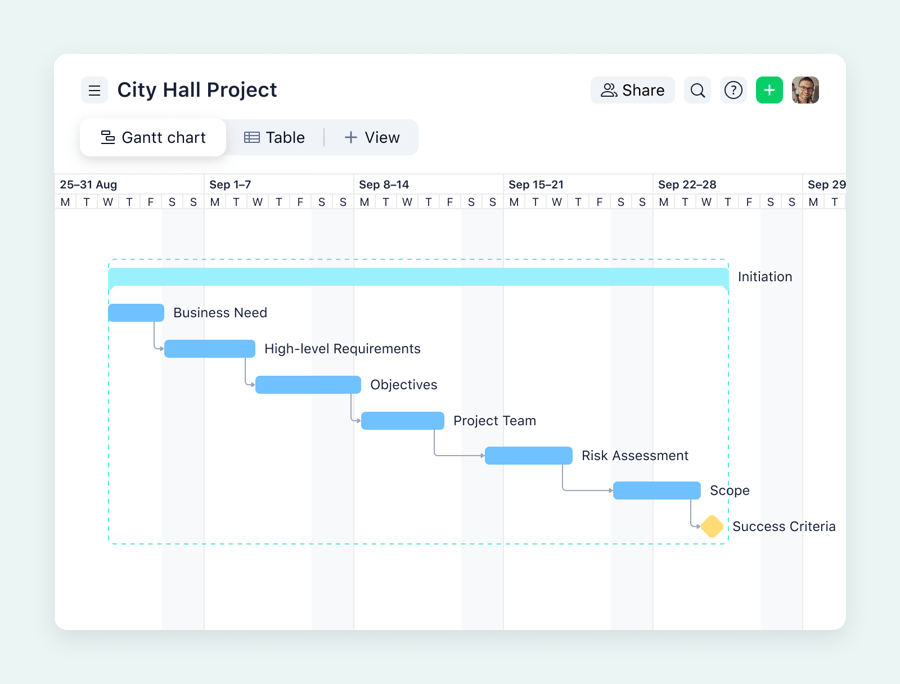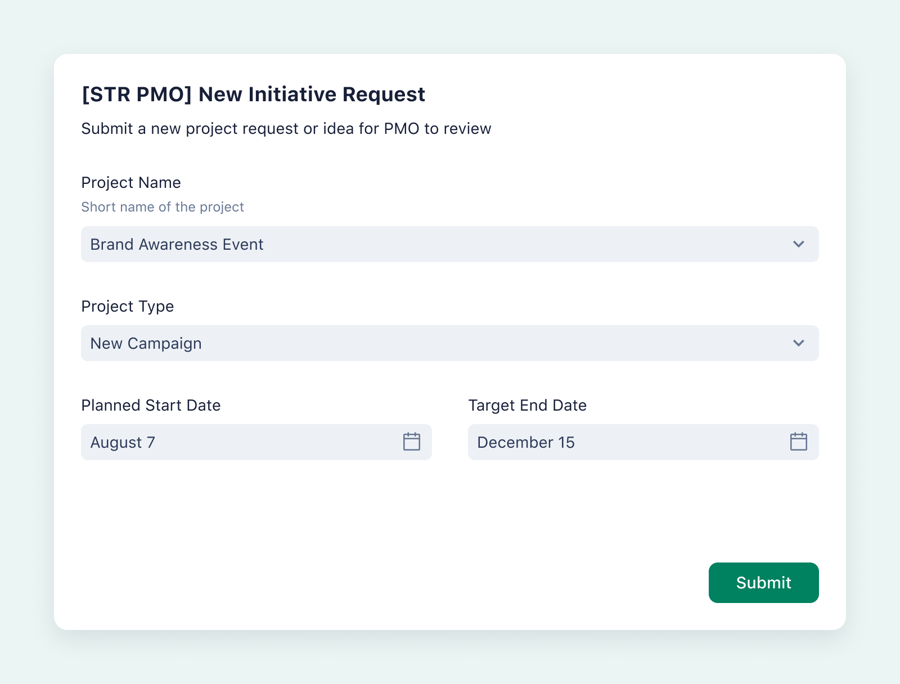What exactly is a problem statement? It’s a concise description of an issue that needs resolving. It helps everyone on the team understand the challenge at hand without any guesswork.
A good problem statement should be clear and precise. For instance, saying “Sales are down” is too broad. It’s more actionable to say, “Sales of product X have declined by 20% in the past six months due to increased competition and a recent price hike.” See the difference? The second one gives you a clearer picture of what’s going wrong and some hints at possible underlying causes.
In this guide, we’ll explore the importance of problem statements, discuss the steps to writing a compelling one, and point out common mistakes to avoid. We’ll also show you how to use our platform, Wrike, to craft the perfect problem statement.
Address problems quickly with Wrike — start your free trial now.
Why are problem statements important?
A problem statement is the starting point for resolving any issue. It allows key stakeholders — including researchers, scientists, entrepreneurs, and project managers — to identify a specific issue or challenge that needs to be addressed.
By clearly defining the problem, the entire team can align their efforts toward finding a solution. With a problem statement, researchers may find themselves lost in a sea of information, unsure where to focus their efforts.
A well-defined problem statement clears up any confusion. It zeroes in on what the real issue is, preventing teams from getting sidetracked by irrelevant tasks. For example, if a team works to enhance customer service, a precise problem statement helps pinpoint specific customer pain points, ensuring that improvement efforts are correctly directed. When teams know what they’re looking for, they can focus on gathering only relevant data, making their analysis more actionable.
The role of problem statements in research
Why are problem statements important in research, and what role do they play? Let’s break it down! A problem statement sets the tone for your research. It tells everyone — from fellow researchers to potential funders — exactly what you’re investigating and why it matters. Think of it as your research’s elevator pitch! Problem statements are the foundation on which research projects are built.
But it also goes beyond making a good first impression. A solid problem statement helps you stay laser-focused. It keeps you on track, constantly reminding you of the core issue you’re solving so you don’t stray into irrelevant territories.
And here’s another cool thing: it drives your research design. Once you’ve nailed down the problem, you start to see what data you need to collect, what methods to use, and whom to involve. For example, if your problem statement is about understanding why customer satisfaction is dropping at a retail store, you’d look into customer feedback, sales data, and perhaps even staff interviews. Each piece of your research puzzle starts with understanding the problem deeply.
Lastly, problem statements provide a basis for evaluating the success of a research project. By comparing the initial problem statement with the final results, researchers can determine whether they have effectively addressed the identified issue.
How problem statements drive innovation
Do you know a simple problem statement can kick-start a wave of innovation? It’s pretty amazing how much impact a few well-chosen words can have.
When you create a problem statement, you set the stage for what could go right. It’s a call to action that says, “Hey, here’s something that needs fixing, and we have the chance to do something great with it!” This challenge can energize the team, sparking creativity and encouraging everyone to think outside the box.
Entrepreneurs with a clear problem statement can focus their efforts on finding creative and effective solutions. This targeted approach increases the chances of developing products or services that make a difference in people’s lives. It also helps differentiate a company from its competitors by offering unique solutions to common problems.
Moreover, problem statements catalyze brainstorming and ideation sessions. By clearly defining the problem, entrepreneurs can gather a diverse team of individuals who contribute their unique perspectives and expertise.
So, the next time you write a problem statement, think of it as more than a formality. See it as the spark that could ignite your team’s creative potential and drive innovation. It’s your first step toward solving a problem and opening a world of new possibilities!
How to write a strong problem statement
Ready to craft your problem statement? You need to follow a few key steps:
1. Identify the problem
Identify the issue you want to address by conducting thorough research, gathering relevant data, and analyzing the situation. During the identification process, asking yourself the right questions is essential to gain a deeper understanding of the problem and its significance.
- What is the problem you are trying to solve?
- Who is affected by this problem?
- Why is it important to find a solution?
Specificity is key here. You need to dig deep and understand the ins and outs of the issue. This isn’t just about stating, “Our sales are dropping.” Instead, you need to pinpoint why they are dropping.
- Is it due to increased competition?
- Is it because of changes in customer preferences?
- Is it due to a recent price increase?
Collect data that illustrates the problem. This could be customer feedback, performance metrics, or observations from team members. Accurate data helps to anchor your problem statement in reality, making it more tangible and urgent. Talk to various stakeholders involved in or affected by the issue — each group might have unique insights into the problem and why it matters. The more specific you are, the clearer the path to a solution.
You can use customizable templates in Wrike as a structured guide to correctly define problems. These templates can be tailored to include specific criteria relevant to the business or project, ensuring all necessary aspects are considered. This structured approach helps ensure all team members articulate the problem comprehensively, ensuring better understanding and alignment across the organization.

2. Analyze the impact of the problem
Once you’ve identified your problem, the next step is analyzing its impact. Problems rarely exist in isolation. They often create a ripple effect, impacting various parts of your operation.
For instance, if the problem is a buggy software release, its effects could range from increased customer support calls to disrupted user experiences and potential revenue loss. Charting these ripple effects helps you understand the full scope and urgency of the problem.
Numbers speak louder than words. Whenever possible, attach data to the effects you’re analyzing.
- By what percentage has customer satisfaction dropped?
- What’s the exact increase in call volume to customer service?
Quantifying these effects makes the problem more tangible and creates a sense of urgency among stakeholders, which will garner support for implementing changes.
Wrike’s analytics boards will be your best friend here, helping you track data in a clear, visual way. You can also create custom reports with specific fields to track each metric.

3. Propose a feasible solution
When you offer a potential solution early on, it does several things:
- It sets a clear direction.
- It motivates your team.
- It shows stakeholders that you’re not just about problems but about answers, too!
In this step, you can demonstrate your proactive problem-solving approach and encourage others to contribute their ideas and insights. This collaborative effort can lead to innovative solutions that effectively address the problem.
Take the example above: you could solve the buggy release problem by asking your team of developers to stall non-urgent tasks so they can collaborate to push through a patch or fix quickly. You can then implement a more robust QA testing process to avoid this issue in future.
Why not use Wrike’s Gantt chart to create a visual timeline for your solution? It’s likely that any major changes will involve multiple stages or dependencies. A Gantt chart can help illustrate how these stages can be effectively managed and sequenced.
For instance, if you need to roll out a new software system, the Gantt chart can display key milestones such as initial testing, full deployment, and follow-up reviews, ensuring that all stakeholders can see the timeline at a glance and understand the phased approach.

Common mistakes to avoid when writing problem statements
While writing problem statements, it’s important to be aware of common pitfalls that can undermine their effectiveness. By avoiding these mistakes, you can see to it that your problem statement truly captures the essence of the problem and inspires effective problem solving.
Overcomplicating the problem statement
When it comes to writing problem statements, it’s easy to overcomplicate things. We all want to sound smart and thorough. But have you ever heard of the KISS principle? “Keep It Simple, Stupid.” It’s harsh but effective.
Your goal should be to communicate the essence of the problem in as few words as possible. A concise problem statement ensures that everyone — from team members to stakeholders — understands the issue right away.
When crafting a problem statement, think about the end users or individuals who will be impacted by it. Consider their level of understanding and familiarity with the subject matter. Avoid using technical jargon or convoluted language that may confuse your audience.
Neglecting the problem’s impact
Identifying an issue is one thing, but understanding and communicating its consequences can drive the point home. Why does this matter?
A problem statement without clearly articulating the impact won’t get the attention it deserves. Whether it’s loss of revenue, decreased customer satisfaction, or internal inefficiencies, the impact paints a picture of the urgency and significance of the issue.
Numbers can be compelling here. Whenever you can, quantify the impact. Saying “Our customer satisfaction has decreased due to long wait times” is one thing, but “Customer satisfaction has plummeted by 40% in three months due to additional wait times of 15 minutes” packs much more punch. This quantification makes the problem more tangible and sets a measurable target for the solution.
Also, don’t forget to consider the long-term effects of the problem. Will it continue to worsen if left unaddressed?
Proposing an unrealistic solution
The most effective problem statements propose practical and achievable solutions within the given constraints, such as budget, time, and resources. For example, proposing to develop a complex software solution in a week when such a task typically takes months sets you up for failure and frustrates your team.
When considering potential solutions, thoroughly analyze the available resources and capabilities.
- Are there any existing technologies that can be tweaked?
- Are there frameworks that can be leveraged?
- Are there any budgetary or time constraints that need to be considered?
Seek input from experts or individuals with relevant expertise. Conducting pilots or feasibility studies is a good strategy to avoid proposing unrealistic solutions. These smaller, controlled tests can help you gather data on how a solution performs in real-world settings.
For example, before rolling out a new IT system across the whole company, implement it in one department first. This approach helps identify potential issues and gauge the practicality of a wider rollout.
Ignoring stakeholder input
Have you tried fixing something without asking the people it affects first? It can be a mess, right? Well, that happens when you skip talking with all relevant stakeholders. They might have insights that could shift your understanding of what’s happening.
So, always make the rounds — chat, listen, and gather all those important viewpoints to ensure your problem statement resonates with everyone involved. As responses and feedback come in, use Wrike to gather and organize this information. This can involve setting up request forms that feed directly into your project space.
How to communicate problem statements effectively using Wrike
A good problem statement can inspire your team to explore new angles and perspectives. With Wrike, you can centralize all communications related to a project. This means every team member can see the problem statement, understand its context, and refer to it anytime. Just share your problem statement in a dedicated project folder, and everyone’s on the same page!
If you need to grab someone’s attention or specific input, use Wrike’s @mention feature. This feature alerts the mentioned person, ensuring they see and can respond directly to the problem statement.
You can also break down the problem statement into actionable tasks and subtasks within Wrike. For example, if your problem statement involves improving customer service response times, you can create individual tasks for customer examples to review current response times, identify delays, and brainstorm potential improvements.
Finally, dashboards in Wrike can also be powerful for keeping the problem statement visible and tracking progress on addressing it. Customize your dashboard to show progress on the problem statement, including the current status of each task.
Celene Curry from Goodwood, a Wrike customer, says:
Ready to write an effective problem statement using the expert guidance provided by Wrike? Try our platform for free.“Wrike means that all those little issues that we usually find out once they’ve become a problem on-site, we can plan for.”
Note: This article was created with the assistance of an AI engine. It has been reviewed and revised by our team of experts to ensure accuracy and quality.



